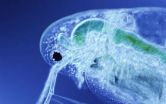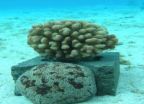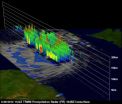(Press-News.org) It seems that "Lucy" was not the only hominin on the block in northern Africa about 3 million years ago.
A team of researchers that included Johns Hopkins University geologist Naomi Levin has announced the discovery of a partial foot skeleton with characteristics (such as an opposable big toe bone) that don't match those of Lucy, the human ancestor (or hominin) known to inhabit that region and considered by many to be the ancestor of all modern humans.
The discovery is important because it provides first-ever evidence that at least two pre-human ancestors lived between 3 million and 4 million years ago in the Afar region of Ethiopia, and that they had different ways of moving around the landscape.
"The foot belonged to a hominin species -- not yet named -- that overlaps in age with Lucy (Australopithecus afarensis). Although it was found in a neighboring project area that is relatively close to the Lucy fossil site, it does not look like an A. afarensis foot," explains Levin, an assistant professor in the Morton K. Blaustein Department of Earth and Planetary Sciences in the Krieger School of Arts and Sciences.
A paper in the March 29 issue of Nature describes this foot, which is similar in some ways to the remains of another hominin fossil, called Ardipithecus ramidus, but which has different features.
Its discovery could shed light on how our ancestors learned to walk upright, according to Levin.
"What is clear is that the foot of the Burtele hominin was able to grasp items much better than its contemporary, A. afarensis, would have been able to do, which suggests that it was adept at moving around in trees," says Levin, who was part of a team led by Yohannes Haile-Selassie of the Cleveland Museum of Natural History that also included researchers from Case Western Reserve University and the Berkeley Geochronology Center.
The finding is important, Levin says, because it shows that there is much more to learn about the role of locomotion in human evolution.
"This fossil makes the story of locomotion more complex, and it shows that we have a lot more to learn about how humans transitioned from moving around in trees to moving around on the ground -- on two legs.This fossil shows that some hominins may have been capable of doing both," she says.
The fossil, dated to approximately 3.4 million years ago, was discovered in 2009 in sediments along the Burtele drainage in the Afar region of Ethiopia that is now very hot and dry. The researchers believe the area was wetter and more wooded when the Burtele hominin lived, based on its deltaic sedimentary context, results from isotopic studies and the range of fossil animals found near the site.
"We're just at the beginning of understanding the environmental context for this important fossil. It will be a critical part of understanding this hominin, its habitat and the role that the environment played in its evolution," she says.
INFORMATION:
Related link:
Naomi Levin: http://eps.jhu.edu/bios/naomi-levin/index.html
Newly discovered foot points to a new kid on the hominin block
2012-04-02
ELSE PRESS RELEASES FROM THIS DATE:
US stockpile security and international monitoring capabilities strengthened, says new report on technical issues behind the comprehensive nuclear test ban treaty
2012-04-02
WASHINGTON — The United States is now in a better position than at any time in the past to maintain a safe and effective nuclear weapons stockpile without testing and to monitor clandestine nuclear testing abroad, says a new report from the National Research Council. The report, requested by the Office of the Vice President and the White House Office of Science and Technology Policy, reviews and updates a 2002 study that examined the technical concerns raised about the Comprehensive Nuclear Test Ban Treaty (CTBT). The report does not take a position on whether the U.S. ...
Planet under Pressure conference, London: Final statement
2012-04-02
Scientists issued the first "State of the Planet" declaration at a major gathering of experts on global environmental and social issues in advance of the major UN Summit Rio+20 in June.
The declaration opens: "Research now demonstrates that the continued functioning of the Earth system as it has supported the well-being of human civilization in recent centuries is at risk." It states that consensus is growing that we have driven the planet into a new epoch, the Anthropocene, where many planetary-scale processes are dominated by human activities. It concludes society ...
Evolving to fight epidemics: Weakness can be an advantage
2012-04-02
When battling a deadly parasite epidemic, less resistance can sometimes be better than more, a new study suggests.
A freshwater zooplankton species known as Daphnia dentifera endures periodic epidemics of a virulent yeast parasite that can infect more than 60 percent of the Daphnia population.
During these epidemics, the Daphnia population evolves quickly, balancing infection resistance and reproduction.
A new study reveals that the number of vertebrate predators in the water and the amount of food available for Daphnia to eat influence the size of the epidemics and ...
Lung cancers detected by CT screening grow as fast as those found with traditional methods
2012-04-02
A new study led by researchers at Mount Sinai School of Medicine indicates that CT scans are more effective than traditional lung cancer detection methods at identifying aggressive lung cancers in their most treatable stages. The data, published online March 27 in the journal Radiology, demonstrate that lung cancers found through annual CT screening are similar to those found in routine practice, both in terms of tumor growth rates and cell-type distribution. In fact, the report showed that 79 percent of the cases diagnosed through annual repeat CT scans were detected at ...
Penn biologists identify a key enzyme involved in protecting nerves from degeneration
2012-04-02
PHILADELPHIA –- A new animal model of nerve injury has brought to light a critical role of an enzyme called Nmnat in nerve fiber maintenance and neuroprotection. Understanding biological pathways involved in maintaining healthy nerves and clearing away damaged ones may offer scientists targets for drugs to mitigate neurodegenerative diseases such as Huntington's and Parkinson's, as well as aid in situations of acute nerve damage, such as spinal cord injury.
University of Pennsylvanian biologists developed the model in the adult fruit fly, Drosophila melanogaster.
"We ...
NIH study finds women spend longer in labor now than 50 years ago
2012-04-02
Women take longer to give birth today than did women 50 years ago, according to an analysis of nearly 140,000 deliveries conducted by researchers at the National Institutes of Health. The researchers could not identify all of the factors that accounted for the increase, but concluded that the change is likely due to changes in delivery room practice.
The study authors called for further research to determine whether modern delivery practices are contributing to the increase in labor duration.
The researchers compared data on deliveries in the early 1960s to data gathered ...
Preventing home invasions means fighting side-by-side for coral-dwelling crabs and shrimp
2012-04-02
As any comic book lover knows, when superheroes band together the bad guys fall harder. The strength that comes in numbers is greater than the sum of its parts.
The same holds true, researchers have recently learned, when different species of crabs (genus Trapezia) and snapping shrimp (Alepheus lottini) in the central Pacific band together to defend their coral homes from hungry seastars. In these frequent conflicts "one-plus-one doesn't always equal two, sometime it is more," explains Seabird McKeon, a marine biologist at the National Museum of Natural History's Smithsonian ...
Study supports using virtual environment to teach mind/body techniques
2012-04-02
A small study from Massachusetts General Hospital (MGH) researchers found that online virtual communities may be an effective way to train patients in meditation and other mind/body techniques. The ability to learn and practice approaches that elicit the relaxation response – a state of deep rest that has been shown to alleviate stress-related symptoms – in a virtual environment could help surmount several barriers that can restrict participation.
"Our finding that a medical intervention – in this case teaching a mind/body approach that includes the relaxation response ...
NASA sees Typhoon Pakhar headed for Vietnam landfall
2012-04-02
The first typhoon of the northern hemisphere 2012 typhoon season is headed for landfall in Vietnam. NASA's Aqua and TRMM satellites have been providing forecasters with valuable data on Typhoon Pakhar, that includes rainfall rates, cloud extent and temperature.
The Tropical Rainfall Measuring Mission (TRMM) satellite flew almost directly over Pakhar when it was a newly formed tropical storm in the South China Sea on March 29, 2012 at 1122 UTC/4:22 p.m. Asia local time (or 7:22 a.m. EDT). The intensifying storm had wind speeds of about 45 knots (~52 mph/~83 kph) and was ...
Images capture split personality of dense suspensions
2012-04-02
Stir lots of small particles into water, and the resulting thick mixture appears highly viscous. When this dense suspension slips through a nozzle and forms a droplet, however, its behavior momentarily reveals a decidedly non-viscous side. University of Chicago physicists recorded this surprising behavior in laboratory experiments using high-speed photography that can capture action taking place in one hundred-thousandths of a second or less.
UChicago graduate student Marc Miskin and Heinrich Jaeger, the William J. Friedman and Alicia Townsend Friedman Professor in Physics, ...




